Interview with Buggy Rollin
You certainly have heard of Buggy Rollin, and the name of Rollerman immediately makes you think about the wheel armor that’s so famous in the roller-skating world… But does the name of Jean-Yves Blondeau ring your bell? Let’s meet the inventor of the famous suit.
Par alfathor
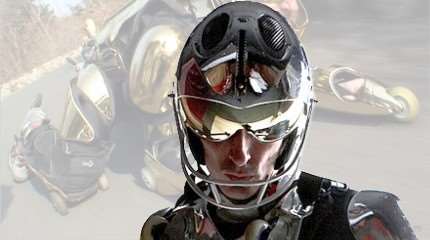
Jean-Yves Blondeau…
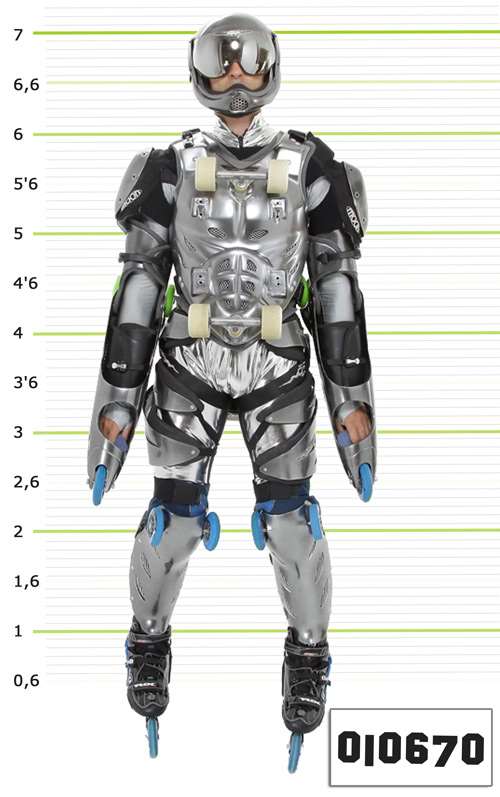
Technical facts
Name: Jean-Yves
Surname: Blondeau
Pseudonym: Rollerman / Buggy Rollin
Birth date: June, 1st
Size: 1m80 without skates on
Weight: 73 kg without armor on
Born in: between lake and mountain
Living in: on Earth
Practicing since: 1977
Category: Science fiction, urban legend
Studies: Industrial design
Occupation: Show-man, stunt-man, consultant director, actor
Strong points: creative, all-rounder
Points to improve: all
Other sports: butt boarding, bmx-ing, cross-country skiing, skwall, Alpine skiing, monoskiing, snowblading, sailing, airboarding, dirtsurfing
Favorite sportsperson: Yves Rossy (jet man flying with a rigid wing)
Last movie seen: “Rollerman, the Rebirth of Golden Suit” (HA HA HA)
Favorite music: Daft Punk / TRON, Frou Frou / Let Go, Tom York / Hearing Damage, Other Lives / For 12, M83…
Video games: The one I want to create
Books: Yves Maniette / “Les Kanji dans la tête”, comics, cyber punk mangas, scientific magazines.
Favorite figurines: Yukata, Hakama, (when you leave the armor you feel like a samurai)
Loving: my future wife
Hating: Malice, injustice, quest for profit, disrespect
Qualities: to be shared and discovered together
Drawbacks: to be turned into qualities
Club: FIBRA First International Buggy Rollin Association, Yaban Doju Incheon, Downhill Extremer Korea
Team/Sponsors: Buggy Rollin, SebaSkates, Matter Wheels, HMR Helmet
Best memory: 1997 IRCL Lausanne
Worst memory: erased
Spoken languages: French, German, English, a bit of Korean, having a go at Chinese, dreaming of Japanese.
Alcohol or fruit juice? Mango juice
Ice or roller-skating? Roller-skating first, then ice-skating
Road or track? A very steep downhill road with bends and a perfect ground
Sprint or marathon? Downhill, it’s faster!
Soft or hard wheels? 83-85 A
Sea or Mountain? Mountain for sure!
Morning or evening? Night
Cheese or desert? Comté, Morbier, Reblochon
Rap or Techno? Electro
Football or rugby? No! I say yes to rolling and gliding!
Simple or double push? Always double, and with the arms?
Prize list? Doesn’t matter…
- 116 km/h ?
- The only one who ran over 9 bobsled tracks?
- 4.8 million click on Youtube?
Questions…
Hello Jean-Yves, I don’t think I’m mistaking in saying that most of skaters know Buggy Rollin, but that in the end we don’t really know much about your history in the world of skating. Could you present yourself?
I’m from a big family with 7 kids. During the after-war, my father used to practice ski jumping in the Jura (nb: French mountains) but didn’t have enough money to buy a pair of skis. He used to make them himself… just as we used to make our toys ourselves.
For example in the 70’s the first skateboards arrived in France. My brothers dismantled skates with straps to build skateboards…
In the 80s we could find pictures of American roller-skates that we couldn’t find in shops. One of my brothers bought glass fiber skateboards, cut them to keep the trucks. My first pair of skates was made of football shoes and skateboard trucks, I was around 10. We really grew up in the Do It Yourself culture.
I did my first skating race at Rumilly (France, 74) at age 11. My result was pathetic. But I won the slalom competition.
Later, my high school was far from home so I was at the boarding school. I was really into bmx-ing and bicrossing but I couldn’t take them with me because they were too cumbersome. So I would skate and skateboard after school.
Then I passed my A levels. I wanted to become a designer just like my cousin, but it didn’t work. I took an introductory course which enabled me to enter Applied Arts and Design courses.
One day, I broke my Fiberlite plate… I contacted the French distributor, Templar, and they changed it. At that point, I said to myself that better things could be done in roller-skating. Thus I worked on a new plate concept during my Btec course in Villefontaine near Lyon (France, 69). I proposed my skating project as a free subject to my teachers. I studied everything over to make these quads. I wanted them to be as efficient as inline skates. I conceived trucks that were longer on the outside than on the inside so that the push was better distributed. I skated with them for some years.
I presented this project for the competitive examination to enter the Olivier de Serres ENSAAMA (Superior national school of Applied arts and Art Professions) in Paris. My drawings were clear, it was practical, they liked it, and I passed!
As a subject for my last year, at first I wanted to make a motor surf for road driving: the power of a motorbike, standing on a vehicle with your arms free… that’s strong! But in a national school, jury members are usually big shots… And when I was asked if I wanted to drive this vehicle on the road, I answered “Of course!”… They turned my project down: forbidden and too dangerous!
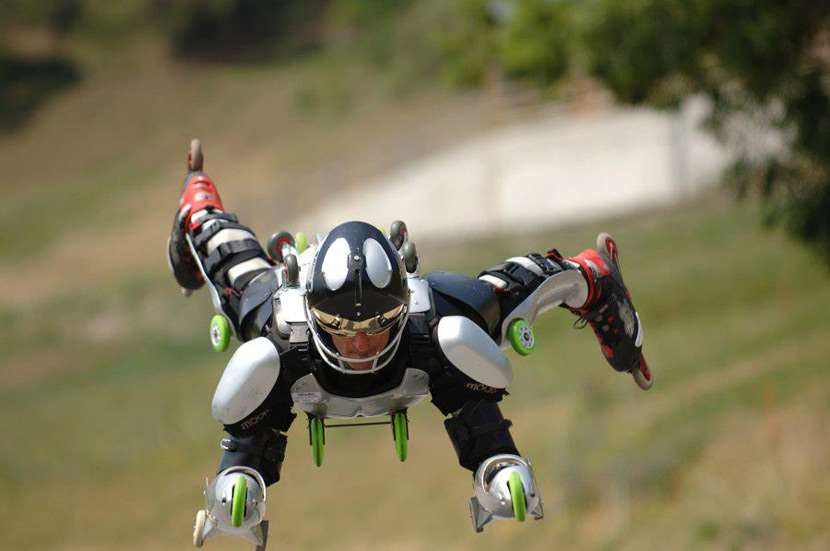
How did you bounce back?
During my studies, I was going to school by skate, I always had a pair with me. I used to live in the 13th district in Paris, and I had to go to the 15th district. I was interested in means of locomotion and the balance sensations of the human body. During one year, I searched all the systems to obtain this: everything that rolls, jumps, crawls, flies. I went to interview athletes at the INSEP, jumpers, divers, runners, circus people… I spent a lot of time at the library in Beaubourg to study the perception of space and balance from a medical point of view. There are lots of French experiments on these subjects.
At the end of that year, I had listed a lot of data on risk-taking amongst young people. Thanks to my high school course in mechanical engineering, I can study dynamic and static forces. One of my goals in this study was to find a physical and mechanical system and connect it to sensations. At that time I hadn’t made any armor yet, just studies. I wanted to use all the technologies that I knew to find the answers. I noticed that there were numerous holes in the gliding postures in sports, particularly in systems for rolling. Then I started to think on a way for rolling in every position… where to place wheels… this is how the armor project was born.
How did the stories of the armor and of Rollerman start?
I made my first armor on June 1994 at school. It only took me one month to decide that it would be an armor, to create the concept, build the prototype and try it. It went very fast. And it was satisfactory for the teachers.
For the record, two days before getting my certificate, I had to go from the campus to the uni with the armor. I had to put it on because it was too cumbersome to be carried. I got very astonished looks from people in the streets.
We went for a photo-shoot on the Trocadero before tourists arrived. I had no idea of what I had created; I had my nose to the grindstone. I had already found the identity of the helmet because I thought it was important, but the rest was still conceptual. I opened the box, speechless. I couldn’t believe what I was looking at. It reminded me of the image of super-heroes, of stranges and marvels, of a universe that I really didn’t appreciate. All those comic books. I’m a comics-lover but my favorite hero is Gaston Lagaffe! I had to adapt my image. A bit like a kid that you deliver and who doesn’t correspond to what you were waiting for: you learn to find what’s good in your offspring.
In 1996, in the Beaubourg Library I dug up a Japanese cyber punk manga: GUNM. The psychology of Japanese mangas is really deep, and fascinating… it corresponded better to the image that I wanted.
Then I went to the army and I registered as conscientious objector and took care of the homeless people. The project remained on standby for two years. During the last months of my objection I could prepare my future and I worked on the armor, registered a name and applied for a patent.
Can you explain the process?
It happened step by step. At school, the first feedbacks I got from my teachers and designers were “It makes you dream…” and “you have to apply for a patent”!
Then I realized that a patent has a life: it’s a legal text and it is valid as long as you respect the procedure, including the taxes you’ve got to pay! At first, it didn’t cost that much. Moreover I had received help for the editorial which is normally very expensive… But the annual installments are bigger every year and go up to 10.000€ per year!
The rolling armor is a patent concerning France, the USA, Russia and Germany. I had to spread it to European countries. Once you’re in you can’t go back. You have deadlines. In France if you forget to pay, it’s over, while in the US you can register again up to 5 years later.
With what means did you make your first armor?
I had no financial means. The school supplied the materials for the glass fiber and resin stratification, as well as the workshop to make it. The arms are made of PVC, and I put wheels, straps, quilting… I tried to play smart. As for the helmet I went to the flea market in Montreuil, I bought one for 5 francs, re-pierced and remolded it as I could. And the foam padding was in fact camping mattress. My father supplied the wheels for the arms: I dug up strollers with 125mm wheels in the back of his house. I cut a pair of skates for the elbows. And I had Kryptonics left for the stomach and the back.
Did you try to find financial or industrial partners?
I had to make my idea known. I met the manufacturers of the time: Benetton (Italy), Oxygen (Austria), K2 (USA), Nike/Bauer, Rossignol (France), Salomon (France). I took my study file, updated it with the brand, pictures and a video. When I presented the concept, the Austrians stood up and applauded but didn’t proceed. Bauer gave me a paper to give to the lawyer, it took time and it didn’t proceed either. Rossignol welcomed me but they turned towards downhill with the “agrafeuse” (stapler – a downhill frame), and I was out of the project.
Salomon proposed me to make a market research to commercialize the project. It took me 4 or 5 months and then nothing. From the industrial point of view, nothing to report…
On the other hand, you seem to have got a good media coverage…
The video that I had sent to the TV show “Nulle Part Ailleurs” on Canal+. They contacted me immediately and sent Marius over (Mr Cinema at Canal+) and Olive. The video was quite creative. We did a remake with greater means. The two guys were skating along with me. The shooting was really great and we even made the most of the fortuitous presence of the police.
The video triggered a chain reaction, and I received requests for photos, interviews and shootings in Elle Magazine, on ZDF in Germany, on Stern TV, then in Holland, and it went on in 1997 and 1998 with the Pink armor. Then things settled down…
I had the opportunity to go to Japan at that time, a magic trip during Christmas in 1998. I discovered the country in being invited by one of the biggest TV channels. I was treated like a star, with someone constantly looking after me and making me visit everything I wanted to. People used to travel less back then, less than now, and it was a real cultural shock! I loved it!
Then I met my German girlfriend in 1999 and I lived in Germany until 2004.
From 2004 to 2007, I went through my Korean phase: I did an advertizing for a big brand and I became a local star, people would recognize me, I would sign autographs, and do several TV show per day.
In 2007 I went back to France…
Do you spend a lot of time in Asia?
I’ve got a South-Korean lover, so I kind of spend a lot of time there. Moreover, I was officially invited for the Leisure Games in ChunCheon, South Korea last year. Thanks to Seba I went to China a lot, for competitions as well as for private events in amusement parks…
Do you earn a living thanks to Buggy Rollin?
Yes I do. I charge my TV performances and I’ve got a partnership with my favorite photographer. We share the photo rights.
I don’t really need to search for clients in the end, people find me. In Germany, I tried to sollicit work… but I didn’t like it. In fact, I was spending my time presenting my thing: it’s a creative, new and original communication vector… and I concluded that the more you run after people the more they don’t care. If they need you, they make sure that everything goes well.
You produce nice videos, they must help for the advertizing…
Yes they do: for example “Swiss Pass” opened new ways. We were on a competition with Denis Strasser in Switzerland, and we were pretty bored. So we decided to go to 6 or 7 passes in the region that were higher than 2000m including the Gottard, Sustern, Grimselpass, Andermatt and the Furka… with wonderful valleys, bends and steep roads. There, we shot “Swiss Pass”, my first success on the Internet. In doing what you really care about, you get what you like. Don’t waste your time with the rest!
The music by Muse is an added value. How did you choose the soundtrack?
We were racking our brains to choose the music, we had no idea. I went to a music store facing the train station. I reviewed dozens of tracks and I hit upon Muse. They were not famous at the time and it really fitted the footage. It was perfect.
I tried to contact them to have the authorization to use their music, but I didn’t have any reply. As a comparison, Daft Punk was cooler for my very first video called “Extrême”. It’s a compilation of different TV shows, including NPA shootings. Alternberg video’s with Tron’s music is great…
This video enabled me to meet Jim Carrey and work on the movie “Yes Man”. One day, I was invited in China for a TV show. My cell rang, I picked it up, and I heard a voice saying “Hi, it’s Hollywood!” They asked me if I wanted to come to L.A. to meet Jim Carrey for his movie “Yes Man”. A very positive side of the experience!
In the end, they didn’t keep a lot of footages… that’s Hollywood! I had to build 4 armors for the movie, one for Jim Carrey, one for Zooey Deschanel, one for me and one for Monica, the stunt-woman who dubbed Zooey…
Did “Yes Man” help for the rest?
In the end no, it didn’t. When the movie was released, I was told “everybody is going to want armors”. Then I hurried to meet an investor to produce some quickly. I told him that I was back from Hollywood and I saw his eyes light up… in fact I got into a real mess with a swindler. I found myself paying everybody in his firm, and ended up broke and without armors. It was in 2009 and I had to start from scratch again. I bounced back in getting a lawyer and going to the police. There were large sums of money involved. The guy was threatening me. I pressed charges. But the case hasn’t been judged yet.
Are the armors tailor-made?
Partly only: they mustn’t hurt, and they have to be comfortable and adjustable to several morphologies. The spare parts are standard but are adjustable to 95% of morphologies. Some details such as the cutting of the straps are tailor-made.
How many versions have you created?
Currently this is my 21st version.
Is this project in constant evolution in terms of technology?
There is no revolution, the concepts I came up with during my study at school are still valid. Above all I want an armor that can go very fast. It is more designed as a Formula 1 than for practicing gymkhana. I want a balanced armor that is reliable and secure at high speed. It’s my vision. If one day slalom-skaters want to have a go at it, it will be different. I use the armor in bobsleigh tracks, which is impossible with most mass-produced skates. This partly explains why the armor is so heavy. It must be resistant. Once I broke a leg of the armor on a raised pavement marker (aka Cat’s Eye) in Busan, South Korea at 90 kph, and the shock was extremely violent. On the whole, it’s really solid: I try to use some common sense.
The shapes are designed according to the position of the wheels and to the shape of the members. The arms are bullet-shaped not to get caught anywhere. The shoulders are round for the same reason. And this is also why the armor is smooth, so that you can safely thread your way through people on lying position during street skates. I tried to stretch the lines. As for the bust with the abs and the chest, this is only an aesthetic choice. I created a character, why not going all the way in the interpretation! The shape of a spoon gives a good balance to the armor: it is convex and shallow, which reacts very well to load. The cutting in facets is inspired from Roman armors – it’s Cinecitta and it gives good reflections, shades and lights. As for the back, rails were needed to take staircases. Mobility was also needed, and this was a bit more complex.
How much does an armor cost?
The current price is 3.500€ for the complete pack (without skates and helmet) including:
- a pair of legs
- a pair of arms
- bust
- back
- shoulder protections
- hip protections
It is set up with wheels and bearings, usable as is… the wheels are of good quality: Hyper, Gyro, Matter depending on the supplier.
When is it going to be commercialized?
I have lots of requests, at least 3 or 4 per day! And even more now with the million cliks three months ago. But I don’t have a solution for the production. I contacted the manufacturer who produces for SebaSkates but he asks too much money even if the work is already spoon-fed. That’s depressing. And yet, my technical file is rock-solid. I say to myself that I have to make them myself, that I have to invest and not own anything to anyone. I make the most of the time I got here in Korea to make an armor, it’s a two-month work! That’s a hard time. Especially when the sewing-machine refuses to work. All in all, the people for whom I make armors are the motivated ones who insist the most!
Do you have problems moving about in the streets or training on open roads?
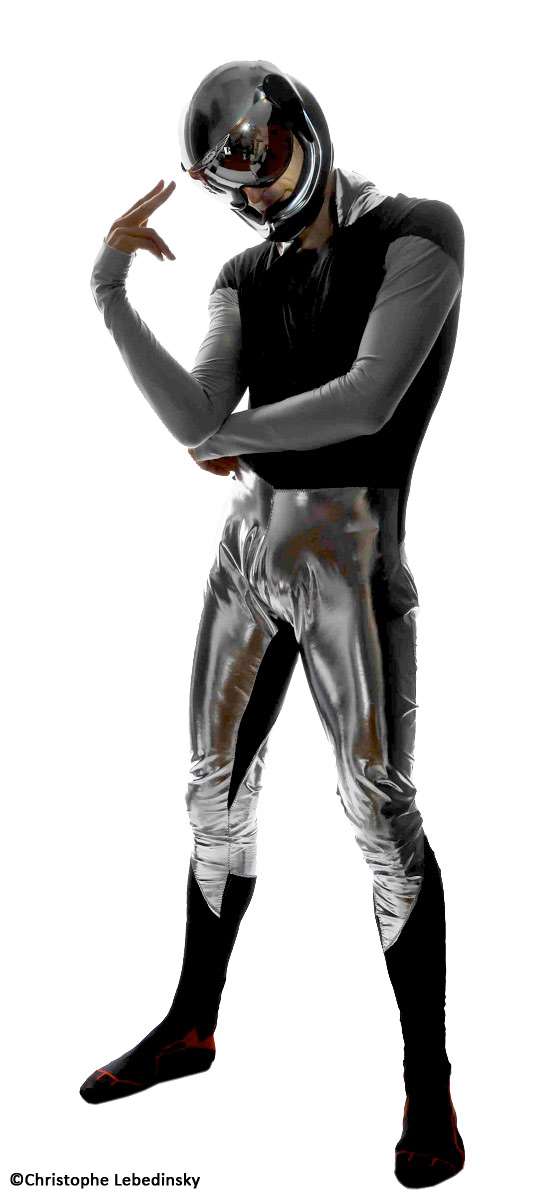
Either you go to free-skating events or to roads you know and you drive it just like a car. I don’t consider Buggy Rollin as an illegal practice. I follow the Highway Code (except maybe for speed limits). In Switzerland, in Lausanne, I arrived a bit fast on a crossroad during a downhill. There was a shooting team and I had to arrive fast… but on the whole, everything goes well with the armor. Maybe because I look like Robocop who’s a member of the police force? In middle age armor meant lord who represent law of god, order, and justice, that generate respect and peace. This is my analysis…
In South Korea there’s no problem at all. The police come to me, we chat… whereas in Germany, they make me walk on the walkways and I have to avoid them. Drive happy, drive discreet! In Korea, somebody who does physical exercise has some values. Doing sports on the road in Korea is validating and well perceived, it shows a particular state of mind.
Did you do big falls?
The armor looks dangerous but in facts it’s got protections all over. When you fall, things usually go well.
After your first fall, you check if everything’s alright in the following seconds, you’re a bit worried. But in the end you realize that the armor only got a few scratches. This is when it becomes dangerous: you think you’ve got nothing to worry about so you take more risks. And the more risks you take the tougher the fall.
Danger also lies in the euphoria of your sensations. I remember an event in Lausanne, ten years ago, in the rain. It was the first armor race ever. It was wet.
When you slide with your armor, you skid but you can pilot which is really fun. But in downhill it goes super fast. My friend Xavier took a bad line during a left bend and when straight, shattered a bale of straw and bent a road sign… He was ok in the end but was traumatized enough to remain 2 days in the hospital. You don’t break because the armor distributes the shockwave, but going from 70 kph to 0 kph in a few tenths of second shakes your whole body, especial your internal organs. You’ve got to put everything back in order and listen to yourself.
I don’t like getting hurt and I avoid falling. Once in Tokyo in 1997, they made me do half-pipe at 7:30 in the morning on a damp surface. I wanted to impress them, I started backwards head first and I landed too low in the curve – not good: I hit my head! It was stupid.
The worst things are still bobsleigh tracks: it goes so fast that you get so compressed that if you throw out, it’s really tricky. Germans say “Die Kake ist in Dampf” (vomit is under pressure). You multiply your speed by 4 or 5G. You’ve got enough time to think of who is going to bring your car back home when you are in the hospital… impressive!
Do you have a specific insurance for your practice?
I subscribed to a life accident clause. My agency called them in showing them what I do. They were accommodating.
If you check out the road before it usually goes fine.
What do you feel when you practice?
When you go straight and really fast, it’s just as if you were flying in a jet. You retract your wings and you tear along! It’s a bit like base-jump or fly-suit, but it’s less dangerous at the landing!
When you put on the armor for the first time, even if you don’t go very fast, you discover brand new sensations. The armor is quite heavy. And even if I tried to adapt the design as much as possible, some movements are limited because of the volumes and the wheels. For example you can’t cross your arms in front of you because of the wheels on your chest.
It’s not easy to cross your legs either because of the wheels on your knees, you experience a new geometry. If you’re itching or you want to take something off of your helmet, you get a bump on the head, it changes everything!
Your appearance changes, but also you identity and you capacities. That’s the second stage: the “super human” level.
Then, you get the power of rolling in every position. You can create wheel courses everywhere: on the ground, on the wall, on the ceiling!
The third stage is the android sensation, the experience in real life and in the present of what could be an exoskeleton, a cyborg, halfway between man and machine.
When you roll, the sensations are so extraordinary that you really have the feeling that you are a cyborg. For example, in a bend when you brake, you press your arm and you can read the ground with the pressure on your flesh, it goes up to your elbow, your shoulder and then your spin. And you can choose to give more pressure, play with the grip, the direction, you can control the pressure on each of the wheels. It’s an explosion of data in your head. It’s quite orgasmic.
When you get on your back head first, I call it “star wars”. In Star Wars 2 there is a scene when they are fighting under the city in the clouds, and it looks a bit like that: the references are upside down. When you experience it by night, with the stars above, you lift your eyes just close to your eyebrows, a visual sector that you never use, and these are brand-new sensations, you’re not used to them and you don’t know how to do. Here you realize that what you experience of the planet is distorted.
Do you sometimes lend your armor?
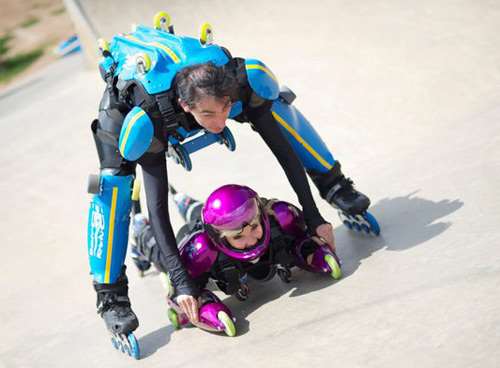 Yes but not without apprehension: you entrust somebody with your armor on which you have spent hours for building it, of which you take care to keep in good condition, which you meticulously put in its case… and a beginner is going to make mistakes and scratch the knees… An armor represents so much work… I always lend the armor number 2 made of carbon at first. I lend it on races or events like the PSWC, the Beton on Fire… but for the moment there are not many candidates.
Yes but not without apprehension: you entrust somebody with your armor on which you have spent hours for building it, of which you take care to keep in good condition, which you meticulously put in its case… and a beginner is going to make mistakes and scratch the knees… An armor represents so much work… I always lend the armor number 2 made of carbon at first. I lend it on races or events like the PSWC, the Beton on Fire… but for the moment there are not many candidates.
How much weighs an armor?
The armor without skates must weigh around 17 kg. The case at the airport with the helmet, the skates, the wheels and the suit weighs 23 kg. I have to negotiate the surplus weight in making puppy eyes all the time. Most of the time, I fly with Lufthansa because I can carry two luggage thanks to my “frequent traveler” status.
How do roller-skates help to drive the armor?
Driving is the right term. First of all, when you can skate, you know how wheels work. That’s the first thing to learn, how to skate with your body. There are a couple of habits to develop. When you deviate off course to the right for example, your knees can solve the problem in pressuring to the left: you’ve got to push to go to the opposite direction. It’s a question of body pattern. All the time you’ve got to think to drive with your whole body, never let one member separate from the body. The rest is quite intuitive.
It is said that you got an armor stolen a few years ago…
Yes I got an armor stolen in Lyon just before leaving for Koenigsee. The car was full. I dropped by to a friend’s to brush my teeth. I said hi, went down and somebody had stolen my R19 because of the alloy wheels!
So that I couldn’t go to the bobsleigh track. I spent the whole month of August looking for it in the sensitive neighborhoods… After one week, the police had found my car in a back street. A neighbor had called. Sometimes it was on a chock, others on wheels. The guy called at the right time. I god rid of the allow rims and replaced them, and I still have my R19 today. But the carbon armor, the best one I had, was missing. At the end of August, I had to go to a TV show in Cinecitta, Italy. I had my armor looked for until the day before I left. I parked in front of the church, and a kid said to come back in a couple of hours in a dead-end street with 1000 Francs. I did so. My bag was waiting close to a staircase with a dozen kids from 12 to 16. I was searched, they were very nervous. I gave the money and got my armor back… but things went wrong. They tried to rob me. They threatened me with pepper spray. In the end, I managed to get my armor back a few hours later… I didn’t get my skates, my clothes and my helmet back, but the armor was what really mattered.
Then I drove all night to try to catch up and arrive on time at the meeting. I arrived in Cinecitta and I was only 10 min late! It was raining around Rome and when it happens, people let their cars in the middle of the streets.
It seems that you travel a lot!
Yes. Japan was my first TV show abroad. I had to move to different events to make the armor known: on bobsleigh tracks, at the ISPO, but also at the YOU Messe (Germany), a show with sports, music and fashion. You can find anything there, and young people can try what they want!
I saw that there is another skater into the concept. Are you ok with your idea being used?
Yes, there are some other skaters, especially Riderman in France. We met in Lausanne to skate together. I had seen pictures. His armor is made of metal. It’s real, heavy metal! Given that I cannot manufacture mass-produced armors, I try to think positive: it’s normal that people who want to practice equip themselves the way they can. If we manage to skate together, we can share sensations and that’s a lot! I don’t push people into making their own armors but into coming to see me and skate with me! Christophe is welcome. I’m going to try to make him a pair of arms…
Last time when I was in L.A., I met Todd Born for “Stan Lee’s Super Human”… We went to visit the shooting place, and we tested the road together.
There is another mad skater called Eduardo, who lives in Bogota. The guys who made their own armor are 100% into it. Otherwise, there are faithful supporters like Seb Bertholet a long time friend who lives in Lausanne, and he’s got an armor that I made and updated. Now he’s got an awesome armor: he’s got 2×5 wheels on the stomach.
I’d like to design a modular chest that everybody can adapt. I think that everybody should be able to set-up and customize their armor the way they want…
Any projects for the future?
The armor is one thing but I’ve got lots of other projects linked to it: video games, cinema, TV series… I’ve been working on the mythology of the character of Buggy Rollin for 12 years! If I manage to commercialize the armor, I’d like to propose the clothes with it!
I also think that it’s possible to create spaces like micro-amusement parks where you could practice with the armor. A place looking like a kind of skatepark with a transparent half-pipe, corridors, pipes, footbridges, high-jumps, foam pool, with a huge “science fiction” maze in the basement where the walls would be moved thanks to robots…
I imagined a Resort too, a hill dedicated to gravity sports with lots of different roads, elevated bends, jumps, bobsleigh tracks without the cooling, a lifting system, accommodation and a restaurant. A vineyard could be planted in the place in-between the roads and in the evening we could drink the harvest… This would be a place for learning, organizing workshops, for holidays. This would also be an excellent support for racing: everything would be already set!
The mass-production of the armor is not an end in itself but rather a stage… almost the first stage!
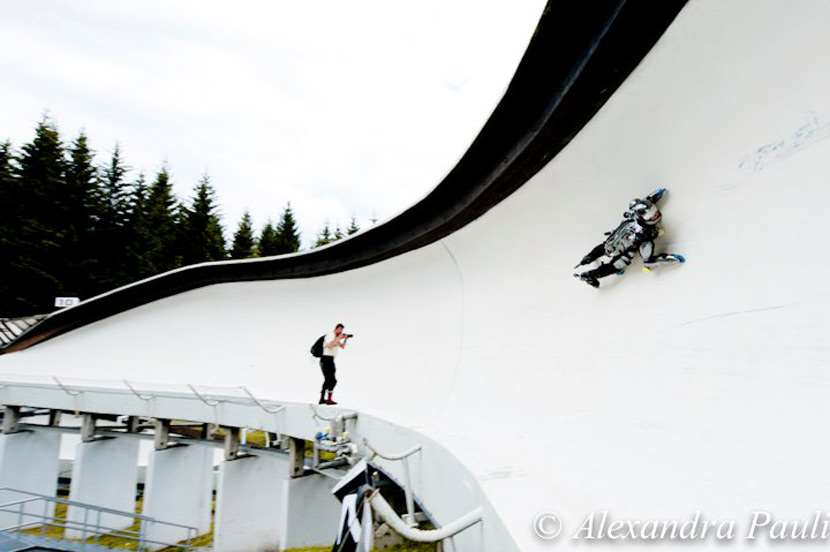
Video: How Buggy Rollin was born
Useful links
Facebook page of Buggy Rollin
Officiel web site of Buggy Rollin
Buggy Rollin in the “Tracks” broadcast (Arte – 2008)
Video : nilloR ygguB + Beauty Aliien
Translated by Close Yr E’s
Photos: Christophe Lebedinsky
Daniel Strasser
and all rights reserved

